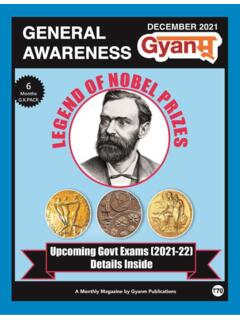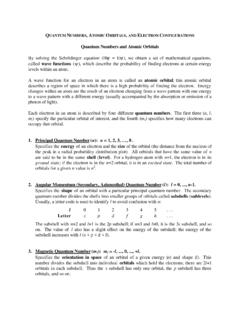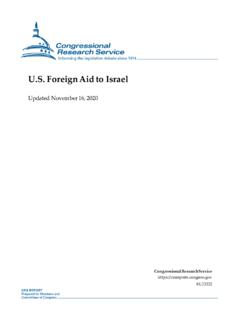Transcription of INNOVATION AND ECONOMIC GROWTH - OECD
1 INNOVATION AND ECONOMIC GROWTH by Nathan Rosenberg Professor of Economics (Emeritus), Stanford University Abstract This paper illustrates why technological INNOVATION is considered as a major force in ECONOMIC GROWTH and focuses on some of the most distinctive features of INNOVATION in the highly industrialized economies of the OECD area. In particular, the paper attempts to examine a primary single feature, uncertainty that dominates the search for new technologies by drawing several cases on the American experience. It also touches on the impact of technological INNOVATION in the tourism industry and how it is transforming the tourism business model. Technological INNOVATION , a major force in ECONOMIC GROWTH It is taken as axiomatic that innovative activity has been the single, most important component of long-term ECONOMIC GROWTH and this paper will start by drawing upon the findings of a very influential paper published by my colleague at Stanford, Prof.
2 Abramovitx, back in the mid-1950s. In the most fundamental sense, there are only two ways of increasing the output of the economy: (1) you can increase the number of inputs that go into the productive process, or (2) if you are clever, you can think of new ways in which you can get more output from the same number of inputs. And, if you are an economist you are bound to be curious to know which of these two ways has been more important - and how much more important. Essentially what Abramovitz did was to measure the GROWTH in the output of the American economy between 1870 and 1950. Then he measured the GROWTH in inputs (of capital and labor) over the same time period. He then made what were thought to be reasonable assumptions about how much a GROWTH in a unit of labour and how much a GROWTH in a unit of capital should add to the output of the economy.
3 It turned out that the measured GROWTH of inputs ( , in capital and labor) between 1870 and 1950 could only account for about 15% of the actual GROWTH in the output of the economy. In a statistical sense, then, there was an unexplained residual of no less than 85%. Surprisingly enough, no economist had ever undertaken this exercise before - partly because it was only after the Second World War that reasonably accurate estimates of inputs and outputs for the American economy, over some very long time period, became available. Now, in any statistical exercise in which you are trying to tease out the relative importance of some variable, and you find yourself with a residual of 85%, you know you are in big trouble! Yet a number of other economists in the late 1950s and 1960s undertook similar exercises, using different methodologies, different time periods, and different sectors of the economy, with roughly similar results they found themselves left with a very large residual that could not be accounted for.
4 Robert Solow, who later won a nobel prize in Economics, was one of those other economists who discovered a very large residual, using a very different methodology and different time period. As it happened, he got the same result for the size of the residual 85%. It was precisely the size of this residual that persuaded most economists that OECD, 2004 1 technological INNOVATION must have been a major force in the GROWTH of output in highly industrialised economies. Although it might be tempting to say that the 85% residual was a negative finding, negative findings can sometimes be extremely useful. In this case the large size of the residual served as a kind of wake-up call to the economics profession because most economists for the previous 200 years had been building models in which ECONOMIC GROWTH was treated as if it was primarily a matter of adding more inputs into the productive process, especially inputs of capital.
5 The large residual told economists that they had to look elsewhere in order to account for ECONOMIC GROWTH . So I am going to focus my attention on some of the most distinctive features of innovative activity in the world of the highly industrialised economies of the OECD countries, and I will draw, in several cases, on the American experience. Actually, I want to focus primarily on a single feature that dominates the search for new or improved technologies, and some of the consequences that flow from this feature. The key word is uncertainty. Dealing with uncertainties It is easy to conclude that, in advanced high tech countries, with large, powerful firms, uncertainties would no longer be a major concern. After all, in the United States today, there are more than 16 000 firms that currently operate their own industrial research labs, and there are at least 20 firms that have annual R&D budgets in excess of USD 1 billion.
6 In fact, when American manufacturing firms are ranked by the size of their R&D budgets, the top 20 firms spent a total of USD 54 billion on R&D in the year 2000. Surely, you might think, such firms are no longer preoccupied with nagging problems flowing from uncertainties and their attendant financial risks. Now, if you thought this, you would be wrong, very wrong, and for two compelling reasons. The first reason, as I have already suggested, is that the conduct of R&D in the high tech sectors of OECD economies has become hugely expensive. The second reason is that the outcome of this R&D spending is fraught with financial risks that derive from a variety of sources. What are these sources? 1. Expenditures on scientific research may simply fail to discover new scientific knowledge of any potential usefulness whatever.
7 2. Even if new scientific knowledge does emerge from research findings at the scientific frontier, it may never lead to a new marketable product. Or, equally important, it may require such a long period of expenditures on new product design or development that business decision makers may conclude that the realisation of a new product is likely to be unacceptably costly unprofitable. But even if research does eventually lead to a new, valuable product concept, many further questions remain to be addressed: 3. How well will the new product perform, not only technologically, but in ECONOMIC terms? Will a high performance be attained, but only at a prohibitively high cost? The Concorde airplane was a simply magnificent achievement in terms of engineering design and speed, but it was also an unqualified financial disaster.
8 It was calculated, when the Concorde project was begun, that 300 of the planes would need to be sold, merely in order to cover its development costs. In the event, only 16 were sold. OECD, 2004 2 4. How rapidly will performance improve and how rapidly is the cost of production likely to decline? 5. How appropriable is the product for the innovating firm? By appropriable I mean, how great is the likelihood that the innovating firm will be able to capture any profits that might be generated by its INNOVATION ? This may depend on whether the INNOVATION is patentable. If not patentable, how soon is it likely to be imitated by competing firms that spent none of their own money in inventing the product? [This is the free rider problem]. 6. It is possible that a government regulatory agency, or a court decision, may destroy expected profits through regulatory requirements or a judicial ruling.
9 In the US pharmaceutical industry the Food and Drug Administration requires that new pharmaceutical products go through a protracted period of testing before they may be sold to the public. Many new pharmaceutical products must be tested for several years before they can be marketed in some cases the testing period may be more than a decade, as in the cases of vaccines or new contraceptive technologies. Estimates of the cost of bringing a wholly new pharmaceutical product to market in the US now routinely exceed the USD 500 million Mark. Additionally, almost everyone in Switzerland must be familiar with ABB s devastating financial losses due to its acquisition of an American firm called Combustion Engineering. It turned out that ABB eventually inherited (if that is the right word) the unexpected liabilities of its subsidiary.
10 These liabilities resulted from the decision of an American court, in a gigantic class action suit, involving the potential damage to human health resulting from Combustion Engineering s extensive use of asbestos. The class action suit has already involved more than 200 000 claimants, with over 100 000 more claimants still to be dealt with. 7. Finally, how soon will a new and superior product come along, either from a competitor or from the introduction of some entirely new technology? It is no paradox to say that one of the greatest uncertainties confronting new technologies is the invention of still newer technologies. There is one further source of uncertainty that I feel obliged at least to insert here, even though it has nothing to do with INNOVATION , and even though you are already painfully familiar with its consequences to tourism.












